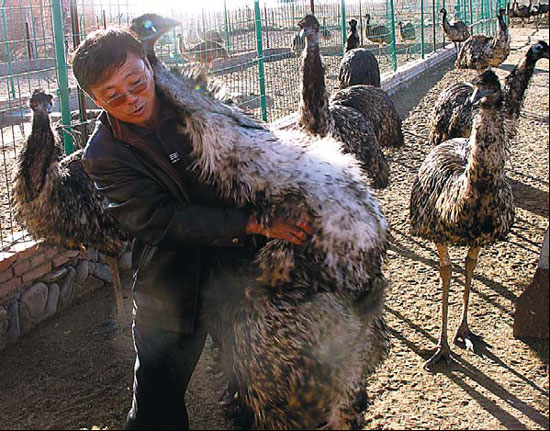Feasible fowl
 |
|
OISCA project officer Wu Hasi checks an emu's health at the NGO's research institute in Alxa, Inner Mongolia autonomous region. Erik Nilsson / China Daily |
A Japanese NGO is piloting a project to replace sheep with emus in Inner Mongolia's grasslands. It could reduce overgrazing and enable ethnic Mongolian herders to earn more. Erik Nilsson finds out more.
|
|
 |
 |
As China's government restricts sheep herding to alleviate the desertification of the Inner Mongolia autonomous region's Alxa grasslands, Japanese NGO the OISCA Institute for Alaxa Ecology is piloting a project to replace sheep with emus. This could reduce overgrazing and enable ethnic Mongolian herders to earn more.
These giant flightless birds can grow to 2 meters tall and weigh 35 kg. Local sheep are 20 to 30 kg - depending on their access to food, which has become scarcer as the Tengali, Badanjilin and Lanbuhe deserts devour Alxa's grasslands.
"The meat from an emu is a bit more than that from a sheep, but the environmental impact of its production is much less," explains OISCA project officer Wu Hasi.
Mutton sells locally for 50-60 yuan ($8-9.6) a kg, while emu meat can go for up to 100 yuan a kg.
There are 66 emus in Alxa, but the project needs 500 to slaughter sustainably.
Wu figures that will take about five years. The birds' numbers have doubled since they were purchased three years ago from Guangdong's provincial capital Guangzhou and Gansu province's capital Lanzhou.
But about 60 died because of inexpert care.
The NGO will give emu hatchlings - eggs incubate for about 55 days - to nomads and ranchers. It will buy them back after they've matured in 18 months.
"Our organization doesn't profit, but local people do," OISCA program officer Su Lide explains.
The NGO will then slaughter the emus and sell their meat for food, their oil and fat for cosmetics, their leather for luxury accessories and their feathers for clothing insulation. It's still studying pricing.
The most valuable emu meat products sold in Guangzhou, Beijing and Shanghai are brisket, jerky and sausage.
Emus sprout two feathers from each quill, making their down warmer than most birds'. These plumes also enable them to endure Alxa's -40 C winter winds despite having evolved in Australia's sweltering forests.
Emus' softball-sized eggs are used for handicrafts and made into cakes in Guangzhou.
"There isn't much emu meat in China's market," Wu says.
"People will buy it as a novelty."
But the giant flightless birds aren't only foreign to China's supermarkets - they're also alien to its ecology.
OISCA is concerned they might become feral or wild.
"That's our biggest fear," Wu says.
"They tend to return to their pens to eat grain, like chickens."
Several ran away in the first year, he says.
"Some we found," Wu says.
"Some we didn't. One turned up in a park years later."
However, because they don't over-consume and are disease resistant, it's unlikely wild emus would threaten Inner Mongolia's grasslands and deserts. The project site's flock prowls behind a high fence and an indoor area.























